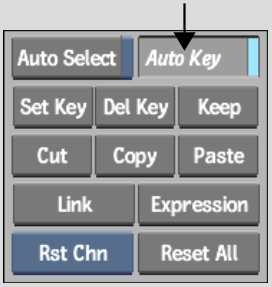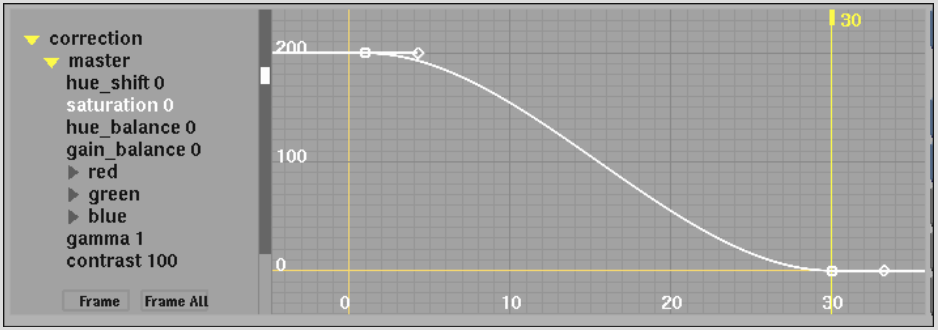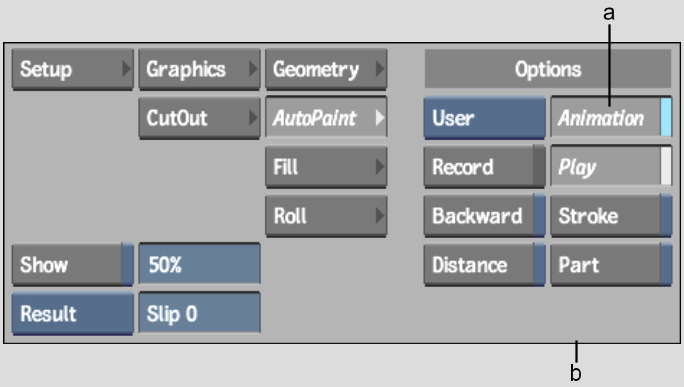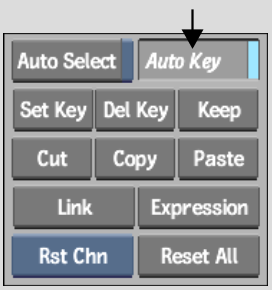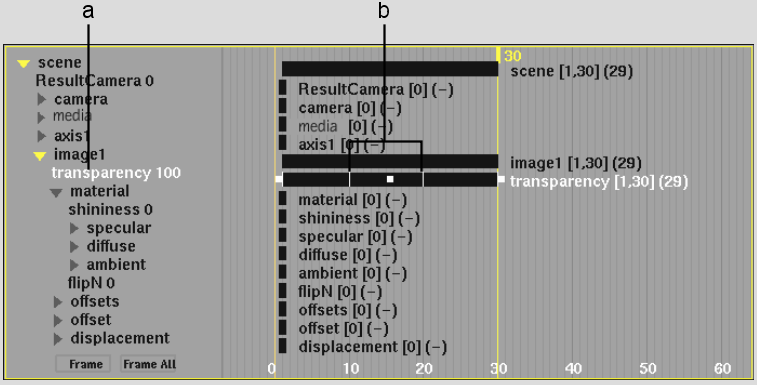Show in Contents

Add to Favorites

Home: Flame

Creating Animations

Creating Animations

Setting Keyframes Manually

Setting Keyframes Automatically
The following procedure illustrates the animation
workflow by describing how to set keyframes automatically for the
saturation channel in the Colour Corrector. Subsequent procedures
illustrate how to create animations in Paint and Action, respectively.
To
animate saturation in the Colour Corrector:
- In
the Colour Corrector menu, enable Auto Key.
When Auto Key is enabled, a keyframe is set
automatically each time you change a value at any frame.
- In
the timebar, position the clip at the first frame.
- In
the channel hierarchy, click
 beside the Master folder.
beside the Master folder.
TipPress
Alt and
click to expand the folder and all subfolders. When several folders
are expanded at once, it can be hard to match animation curves with
their corresponding channel in the channel hierarchy. Collapse folders
you are not using to isolate the channel you want to edit by clicking

. See
Displaying Channels.
- Select
the saturation channel and double-click the value.
- Enter
200.
- In
the timebar, position the clip at frame 30.
- In
the Channel Editor, double-click saturation and enter 0.
The second keyframe is set. The channel name
and curve are highlighted.
You have created an animation that reduces the
saturation over 30 frames.
- In
the Animation controls, click Frame Chn.
The Frame Channel button adjusts the zoom factor
in the Animation Curve window so that the selected curve is displayed
completely. In this way, you can see the full shape of the curve
from the first keyframe to the last keyframe.
- Preview
the result by clicking Process.
- Modify
values, animation curves, and interpolation to refine the animation
until you are satisfied with the result. See
Editing Keyframes and
Setting Interpolation.
- If
you are animating several channels in the Colour Corrector, you
can adjust the timing of the animations. See
Controlling the Speed of Objects.
- If
you intend to create keying and compositing animations, save the
current setup in the Colour Corrector and reload it later in Batch.
In Batch, use the Universal Channel Editor to
synchronize animations among Colour Corrector, Keyer, Action,
and other nodes. See
Synchronizing Animations.
To animate the size and colour of a brush stroke
in Paint:
- Click
Paint, and then click AutoPaint.
The AutoPaint menu appears.
- Set
the following options:
- Enable
Record.
The Record button records the brush strokes.
See
Recording Brush Strokes.
- Create
brush strokes by painting on the clip.
Once you are finished recording the brush strokes,
you are ready to animate the brush and brush stroke attributes.
- Click
below the timebar to stop recording.
Record is disabled and you are in Play mode.
- Enable
Animation.
- Swipe
the bar at the bottom of the Paint menu to display the Channel Editor.
- In
the animation menu, make sure that Auto Key is enabled.
- Move
the positioner to the first frame.
- In
the channel hierarchy, open the Brush folder and set the following
channel values:
- Set
the Size channel to 1.
- Set
the Colour g (green) channel to 12.
- Move
the positioner to frame 7 and set the following channel values:
- Set
the Size channel to 50.
- Set
the Colour g (green) channel to 98.
- Move
the positioner to frame 11 and set the following channel values:
- Set
the Size channel to 66.
- Set
the Colour g (green) channel to 100.
- Set
the Colour b (blue) channel to 48.
- Move
the positioner to frame 30 and set the following channel values:
- Set
the Size channel to 118.
- Set
the Colour g (green) channel to 17.
- Click
Process and then play the clip to view the result of the animated
brush stroke.
To
animate the transparency of media in Action:
- In Action,
load a front, back, and matte clip.
- Add
a surface for the media.
- In
the Action menu, enable Auto Key.
When Auto Key is enabled, a keyframe is set
automatically each time you change a value at any frame.
- Move
the positioner to frame 1.
- Click
Object to display the Image menu.
- Enter
0.0% in the Transparency field.
- Move
the positioner to frame 10 and set the transparency to 16%.
- Move
the positioner to frame 20 and set the transparency to 40%.
- Move
the positioner to frame 30 and set the transparency to 100%.
- Click
Animation and open the image x folder, where x is
an integer representing the image.
- Select
the transparency channel.
Keyframe indicators appear as blue bars in the
timebar.
- Click
Process and then play the clip to view the result of the animated
media transparency.
- If
necessary, edit the timing of the keyframes in the Track Editor to
make sure all of the different animations occur in proper sync.
In a viewport, press F5 until
the Track Editor appears, or select Tracks from the Channel View
box.


